Back in 2015, NASA’s New Horizons probe stunned the world with the first close-up photos of the planet/not-planet Pluto. After that moment, the probe went on further into space, heading for the Kuiper Belt, an area rich in asteroids.
But flying through space is an incredibly boring and resource consuming business. Space is mostly empty, so keeping the probe online while covering the vast distances between objects of interest would have been useless.
Now that New Horizons is approaching by space standards such an object, NASA decided to wake it up to get it ready for the task ahead.
The object of interest is unofficially called Ultima Thule, a phrase which means the extreme limit of travel and discovery. Until March, NASA referred to it in as (486958) 2014 MU69.
The piece of rock is a trans-Neptunian object (TNO). As per the observations made with the Hubble telescope in 2014, it is likely to be an object composed of two bodies that have gravitated toward each other until they came together. The rock measures 30 kilometers (19 miles) in diameter.
New Horizons’ encounter with Ultima Thule is scheduled to take place in January 2019, and the time between the probe’s activation and the rendezvous would be spent by NASA engineers to get it ready for the historic moment.
When the flyby would happen, Thule would become the farthest object in the Solar System ever to be visited by a human spacecraft.
“MU69 is humanity's next Ultima Thule,” said in a statement earlier in March Alan Stern, New Horizons principal investigator from Southwest Research Institute in Boulder, Colorado.
“Our spacecraft is heading beyond the limits of the known worlds, to what will be this mission’s next achievement. Since this will be the farthest exploration of any object in space in history, I like to call our flyby target Ultima, for short, symbolizing this ultimate exploration by NASA and our team.”
Now that New Horizons is approaching by space standards such an object, NASA decided to wake it up to get it ready for the task ahead.
The object of interest is unofficially called Ultima Thule, a phrase which means the extreme limit of travel and discovery. Until March, NASA referred to it in as (486958) 2014 MU69.
The piece of rock is a trans-Neptunian object (TNO). As per the observations made with the Hubble telescope in 2014, it is likely to be an object composed of two bodies that have gravitated toward each other until they came together. The rock measures 30 kilometers (19 miles) in diameter.
New Horizons’ encounter with Ultima Thule is scheduled to take place in January 2019, and the time between the probe’s activation and the rendezvous would be spent by NASA engineers to get it ready for the historic moment.
When the flyby would happen, Thule would become the farthest object in the Solar System ever to be visited by a human spacecraft.
“MU69 is humanity's next Ultima Thule,” said in a statement earlier in March Alan Stern, New Horizons principal investigator from Southwest Research Institute in Boulder, Colorado.
“Our spacecraft is heading beyond the limits of the known worlds, to what will be this mission’s next achievement. Since this will be the farthest exploration of any object in space in history, I like to call our flyby target Ultima, for short, symbolizing this ultimate exploration by NASA and our team.”

